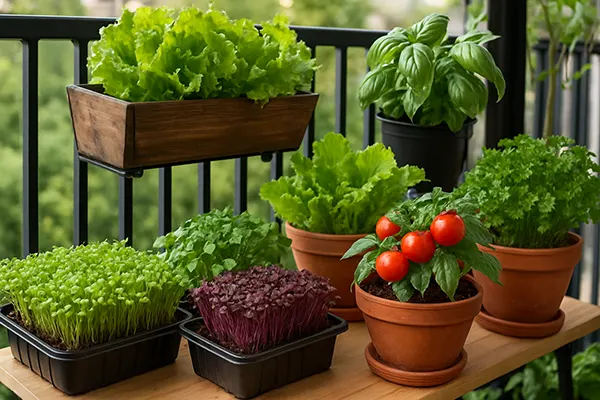“Edible Balcony”: How to Grow a Micro-Farm in a Few Square Metres
In modern cities, where every square metre is valuable, even a small balcony can become a source of fresh food. “Edible balconies” are more than just a trend — they are a real response to the challenges of food sustainability, self-sufficiency and ecological awareness. This article explores how to create a productive micro-farm in an urban apartment, grow vegetables and microgreens, and organise everything with simple DIY methods.
Planning Your Vertical Balcony Garden
Efficient use of vertical space is the key to turning a few square metres into a fruitful garden. Begin by evaluating your balcony’s layout: direction of sunlight, wind exposure, access to water and general weight-bearing capacity. South- and west-facing spaces typically receive more light, making them suitable for sun-loving crops like tomatoes and peppers.
Use vertical shelving units, hanging pots, stackable planters and rail-mounted boxes to create layers of greenery. This not only increases the growing area but also makes plant care more accessible. Place larger containers on the floor, climbers against railings, and microgreens on wall-mounted shelves.
To ensure long-term productivity, plan irrigation and drainage systems. Balcony gardens need consistent moisture, but excess water must drain properly to avoid rot and damage. Install trays under pots, and consider self-watering containers or drip irrigation for easier maintenance.
Choosing the Right Structures and Materials
Durability is crucial in outdoor micro-farms. Opt for galvanised metal shelves or weather-resistant plastic units for vertical constructions. Reuse crates or pallets for DIY racks, but treat wooden surfaces to prevent mould and rot. Hanging pots should be fixed securely, especially on windy balconies.
Weight distribution is also important — avoid placing all containers on one side. Use lightweight soil mixes based on coco coir, perlite and compost to reduce overall load. For balconies with weight restrictions, fabric grow bags are an excellent alternative to ceramic or concrete pots.
Incorporate reflectors or mirrors to boost natural light in shaded areas, especially if your balcony faces north. They help redirect sunlight and improve plant growth, particularly in early spring or late autumn.
Urban Crops: Best Plants for Compact Growing
Some plants are particularly well-suited to small-scale growing. The top choices for urban gardening include microgreens, cherry tomatoes, leafy greens and culinary herbs. These crops don’t require deep soil, grow quickly, and can be harvested multiple times during a season.
Microgreens — such as radish, broccoli, mustard and sunflower — are ideal for beginners. They germinate quickly, need only a shallow tray, and can be grown indoors on windowsills. A single square foot can produce several harvests per month.
Tomatoes (especially dwarf or determinate varieties) thrive in containers. Choose types like ‘Balconi Red’, ‘Tiny Tim’ or ‘Patio Princess’. Combine them with basil or oregano for companion planting that maximises space and improves flavour profiles.
Tips for Crop Rotation and Companion Planting
Rotating crops on your balcony might seem unnecessary, but it helps prevent disease build-up. Avoid planting the same family (e.g. tomatoes and peppers) in the same container for multiple seasons. Switch to leafy greens or legumes between cycles.
Companion planting enhances productivity naturally. Pair lettuce with radishes, which grow quickly and break up soil for later crops. Basil repels pests from tomatoes, while mint helps keep aphids away from leafy vegetables.
Group plants by watering needs to simplify irrigation. For example, keep drought-tolerant herbs like rosemary and thyme in one area, and water-loving lettuce or spinach in another. This approach prevents overwatering and improves overall yield.

DIY Hacks for Growing in Limited Space
Urban gardeners often rely on inventive solutions to compensate for lack of space. Repurposing everyday items can save money and reduce waste. Old shoe organisers, plastic bottles, and fruit crates make excellent vertical planters or mini-beds.
A popular solution is a tiered microgreen station built from an old bookcase or dish rack. Lined with waterproof fabric and placed near a sunny window, it becomes a reliable year-round source of greens. Drill drainage holes and elevate trays to avoid root rot.
To automate care, use timers for grow lights and low-cost irrigation pumps. Affordable LED grow lights (with red-blue spectrum) allow winter cultivation of herbs and greens indoors. Many DIY setups function with basic USB power sources and recycled containers.
Organising a Year-Round Growing Schedule
Planning a seasonal schedule ensures constant harvests. In spring and summer, focus on fast-growing greens and fruiting plants. During autumn, switch to root vegetables like radishes or beets in deep containers. Winter is ideal for indoor microgreens and hardy herbs under lights.
Maintain a simple planting calendar — sow microgreens weekly, herbs monthly, and rotate tomatoes or lettuce with each season. Keep notes on which crops performed best and when to re-seed for optimum results.
Regular feeding with compost tea or organic liquid fertiliser keeps container-grown plants healthy. Use kitchen waste to produce small batches of compost using a bokashi bin or worm tower — compact solutions for apartment life.





